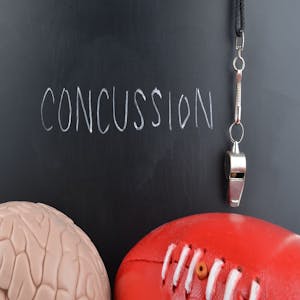
A concussion is an injury to the brain resulting in temporary loss of normal brain function. According to the CDC, a concussion is classified as a type of traumatic brain injury caused by a bump, blow, or jolt to the head.
Concussions can happen at all stages of life, though they are more common in older adults. Adults over the age of 75 typically experience concussions from fall-related accidents. In younger children and adults, a concussion is more likely to occur from things such as sports or motor vehicle accidents.
Symptoms:
Symptoms of a concussion typically appear shortly after the incident occurs. However, it is not uncommon to develop symptoms a few hours or even days later. Concussions do not typically involve structural or visual injuries and there are no physical symptoms. MRI and CT scans are unable to diagnose a concussion, though they can detect any brain bleeding or fracture. Concussions are diagnosed based on symptoms and paper/computer testing.
Top 10 Signs and Symptoms of a Concussion:
- Short term memory loss from right before and right after in incident
- Headache or “pressure” in the head
- Difficulty balancing
- Blurred or double vision
- Sensitivity to light
- Sensitivity to sound
- Confusion
- Feeling down
- Sleep disturbance
- Irritability and personality changes
Protocol:
Following a concussion it is important to allow at least 14 days to give the brain time to heal and recover from the traumatic event. It may not seem like a big deal for young athletes to push through any remaining symptoms following their concussion but ignoring them and returning to an activity too soon can have dangerous consequences.
Second Impact Syndrome (SIS):
Second Impact Syndrome (SIS) can occur if a second concussion is sustained within the first 2 weeks following the initial concussion or with 2 mild concussions obtained close together. SIS causes the brain to lose its ability to self regulate pressure and blow flow volume, which results in increased swelling and exacerbation neurological symptoms. This brain swelling is so serve that the brain begins to press agains the skull, decreasing blood flow. The lack of proper blood flow can result in unconsciousness, respiratory failure and even death. To help prevent SIS, it is important to be aware of your symptoms and the timeline of your concussion, even if your symptoms are mild or resolved completely.
Treatment:
Concussion symptoms usually resolve within a few days or weeks following injury. Symptoms that do not go away with in the expected time frame may require further testing and treatment from a team of health care providers. Prolonged symptoms including headaches, dizziness, mood changes, and difficulty concentrating that persist for weeks or moths after injury are categorized as post concussion syndrome.
Utilizing a treatment team approach including physicians, physical therapists, occupational therapists, nurses, audiologists, coaches, athletic trainers, and parents, is essential in the management of post concussion syndrome.
As part of the treatment team, physical therapists can evaluate and treat many of post concussion related symptoms.
There are no two concussions that are the same. Treatment approaches are based on exam findings looking at orthopedic, neurological and cardiovascular systems.
Top Four Treatment Approaches:

- Rest and Recovery: Rest is an important aspect of the recovery process for a concussion. Rest and recovery involves limiting daily tasks including work, school, sports, recreation and use of electronics. It’s important to return to these activities slowly to avoid overloading your systems and allowing your brain time to heal. Returning to activity is something that should be discussed with your treatment team.
- Improve Dizziness and Balance: Experiencing dizziness and imbalance following a concussion is normal. Physical therapy is a great tool to help reduce these symptoms through vestibular rehabilitation. The vestibular system is located in your inner ear and connects to the brain to help keep you balanced by letting your brain know where you are in space. The connection between the Vestibular System and brain are altered after a concussion. This causes feelings of dizziness or imbalance as well as difficulty with head and eye movements. Physical therapy can help improve these symptoms by “retraining” your vestibular system and brain to work together again. This includes exercises such as balancing on foam and various eye exercises.
- Reducing Headaches: A physical therapist can assess the different possible causes of headaches and use specific treatments to help reduce them. Treatment can include a hands on approach such as soft tissue release and joint mobilization, stretching, strengthening and postural exercises.
- Returning to activity: Improving cardio vascular endurance following a concussion is essential for return to sports and activity safely. Physical Therapists will progress your cardio vascular endurance while monitoring symptoms, heart rate and blood pressure through specially designed programs. These programs help you gradually return normal activity to avoid overloading the brain. Preventing this brain “overload” is important to help control symptom exacerbation which will delay brain healing and return to normalcy.
If you are experiencing symptoms that are restricting your quality of life, consider seeking professional help. Physical therapy is a great resource in managing post concussion symptoms. For more information on how Action Potential can help you, request an appointment today.
